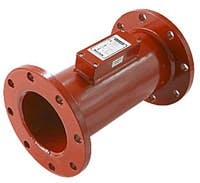Ultrasonic Flow Transmitters Eliminate the Need for Calibration
Clark Solutions has introduced the CSLFC Liquid Ultrasonic Flow Transmitter. These transmitters are designed for measuring flow rates of acoustically conductive liquids, including most clean liquids and many liquids with bubbles and/or entrained solids. CSLFC Ultrasonic Flow Transmitters are engineered for flows up to 4000 GPM in four- to 10-inch pipe, feature no moving parts, excellent long-term stability, no pressure drop, broad fluid compatibility and high accuracy (± 0.75% of full scale) at a lower cost than similar instruments. Wetted materials include ULTEM encapsulated ultrasonic transducers with a choice of EPDM, Buna-N, Neoprene, FKM or other seals and epoxy coated, Schedule 40 carbon steel pipe body material.
There is no element in the fluid stream to add pressure loss, no moving parts and no hysteresis. The output of the transmitter is unaffected by changes in fluid temperature, density and viscosity as the flow calculation is independent of the speed of sound.
At the heart of the transmitter is a proprietary mixed signal ASIC, which allows sophisticated timing, control and transducer drive circuitry to be combined on a single integrated circuit. The ASIC uses a special algorithm that is an improvement upon the standard single-path measurement technique. Using the "sing around" method, the ultrasonic transducer alternates between transmitting and receiving to measure differences in flight time between upstream and downstream transmissions. A sound pulse is transmitted from an upstream transducer towards a downstream transducer, like a traditional time-of-flight measurement. However, the received sound pulse then triggers a second downstream transmission that then triggers a third, and so on, for a specific number of cycles. This process is repeated in the upstream direction. Because it takes an average flight time over multiple cycles to compute the difference in flight times, this approach yields a significant improvement in timing accuracy when compared with the time-of-flight difference of a single sound pulse in each direction. This algorithm, combined with the pico-second timing resolution of the ASIC, provides the precise time measurement capability necessary for compact, small diameter, ultrasonic meters. The output of the transmitter is unaffected by changes in fluid temperature, density and viscosity, as the flow calculation is independent of the speed of sound.




